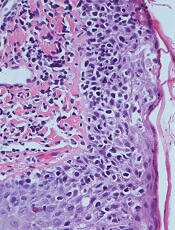
mycosis fungoides
The UK’s Medicines and Healthcare Products Regulatory Agency (MHRA) has granted SGX301 (synthetic hypericin) Promising Innovative Medicine (PIM) designation for the treatment of cutaneous T-cell lymphoma (CTCL).
The PIM designation is the first step toward inclusion in the Early Access to Medicines Scheme (EAMS).
EAMS provides early access to new medicines for patients with life-threatening and seriously debilitating conditions.
PIM status is awarded following an assessment of early nonclinical and clinical data by the MHRA.
PIM designation has been created as an early signal to companies that a product’s development plan is appropriate and indicates that a product could be a candidate for the second phase of the EAMS scheme once further development work has been conducted.
In the second phase, the product is made available to UK patients before a marketing authorization is approved.
The requirements for PIM designation are:
- The condition should be life-threatening or seriously debilitating with a high unmet medical need (ie, there is no method of treatment, diagnosis, or prevention available, or existing methods have serious limitations).
- The medicinal product is likely to offer a major advantage over methods currently used in the UK.
- The potential adverse effects of the medicinal product are likely to be outweighed by the benefits, allowing for the reasonable expectation of a positive benefit-risk balance. A positive benefit-risk balance should be based on preliminary scientific evidence, as justified by the applicant.
About SGX301
SGX301 is a photodynamic therapy utilizing safe, visible light for activation. The active ingredient in SGX301 is synthetic hypericin, a photosensitizer that is applied to skin lesions and then activated by fluorescent light 16 to 24 hours later.
Combined with photoactivation, hypericin has demonstrated significant antiproliferative effects on activated, normal human lymphoid cells and inhibited the growth of malignant T cells isolated from CTCL patients. Topical hypericin has also proven safe in a phase 1 study of healthy volunteers.
In a phase 2 trial of patients with CTCL (mycosis fungoides only) or psoriasis, topical hypericin conferred a significant improvement over placebo. Among CTCL patients, the treatment prompted a response rate of 58.3%, compared to an 8.3% response rate for placebo (P≤0.04).
Topical hypericin was also well tolerated in this trial. There were no deaths or serious adverse events related to the treatment. However, there were reports of mild to moderate burning, itching, erythema, and pruritus at the application site.
A phase 3 trial of SGX301 is currently recruiting patients. SGX301 is under development by Soligenix, Inc.


